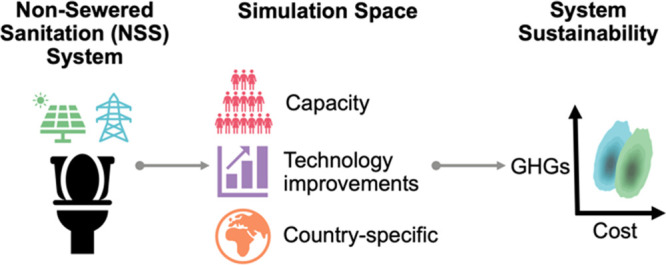- Record: found
- Abstract: found
- Article: found
Advancing the Economic and Environmental Sustainability of the NEWgenerator Nonsewered Sanitation System

Read this article at
Abstract

Achieving safely managed sanitation and resource recovery in areas that are rural, geographically challenged, or experiencing rapidly increasing population density may not be feasible with centralized facilities due to space requirements, site-specific concerns, and high costs of sewer installation. Nonsewered sanitation (NSS) systems have the potential to provide safely managed sanitation and achieve strict wastewater treatment standards. One such NSS treatment technology is the NEWgenerator, which includes an anaerobic membrane bioreactor (AnMBR), nutrient recovery via ion exchange, and electrochlorination. The system has been shown to achieve robust treatment of real waste for over 100 users, but the technology’s relative life cycle sustainability remains unclear. This study characterizes the financial viability and life cycle environmental impacts of the NEWgenerator and prioritizes opportunities to advance system sustainability through targeted improvements and deployment. The costs and greenhouse gas (GHG) emissions of the NEWgenerator (general case) leveraging grid electricity were 0.139 [0.113–0.168] USD cap –1 day –1 and 79.7 [55.0–112.3] kg CO 2-equiv cap –1 year –1, respectively. A transition to photovoltaic-generated electricity would increase costs to 0.145 [0.118–0.181] USD cap –1 day –1 but decrease GHG emissions to 56.1 [33.8–86.2] kg CO 2-equiv cap –1 year –1. The deployment location analysis demonstrated reduced median costs for deployment in China (−38%), India (−53%), Senegal (−31%), South Africa (−31%), and Uganda (−35%), but at comparable or increased GHG emissions (−2 to +16%). Targeted improvements revealed the relative change in median cost and GHG emissions to be −21 and −3% if loading is doubled (i.e., doubled users per unit), −30 and −12% with additional sludge drying, and +9 and −25% with the addition of a membrane contactor, respectively, with limited benefits (0–5% reductions) from an alternative photovoltaic battery, low-cost housing, or improved frontend operation. This research demonstrates that the NEWgenerator is a low-cost, low-emission NSS treatment technology with the potential for resource recovery to increase access to safe sanitation.
Related collections
Most cited references51
- Record: found
- Abstract: not found
- Article: not found
The ecoinvent database version 3 (part I): overview and methodology

- Record: found
- Abstract: found
- Article: found
The Characterization of Feces and Urine: A Review of the Literature to Inform Advanced Treatment Technology
- Record: found
- Abstract: not found
- Article: not found